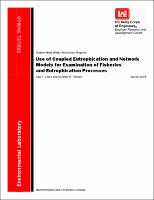Please use this identifier to cite or link to this item:
https://hdl.handle.net/11681/6882| Title: | Use of coupled eutrophication and network models for examination of fisheries and eutrophication processes |
| Authors: | Cerco, C. F. Hamlin-Tillman, Dorothy E. |
| Keywords: | Fisheries--Monitoring Eutrophication--Mathematical models Biotic communities--Mathematical models |
| Publisher: | Environmental Laboratory (U.S.) |
| Series/Report no.: | ERDC/EL; TR-08-10. |
| Abstract: | Abstract: The Corps of Engineers Integrated Compartment Water Quality Model (CE-QUAL-ICM or simply ICM) was designed to be a flexible, widely applicable eutrophication model. Ecopath with Ecosim (EWE) is a freely distributed network model supported by the Fisheries Centre, University of British Columbia. This study aimed to develop a coupling between the two models so that they could be used, in combination, to address management questions concerning the effects of nutrient load reductions on fisheries and the effects of fisheries management on primary producers. Specific objectives included: 1) comparing ICM and Ecopath representations of contemporary conditions in three regions of Chesapeake Bay; 2) comparing ICM and Ecopath representations of conditions in mid Chesapeake Bay following nutrient load reductions to levels consistent with the 1950s; and 3) comparing ICM and Ecopath representations of conditions in three regions of Chesapeake Bay resulting from increased grazing on phytoplankton by menhaden. Corresponding quantities in the two models were identified, and an ICM postprocessor was developed to facilitate the exchange of information between the two models. Significant differences were noted between the two model representations of contemporary primary production, benthic invertebrate biomass, and sediment-water organic carbon exchange. Substitution of ICM computed primary production from a 90% nutrient reduction scenario, intended to simulate loads in the 1950s, into Ecopath indicated that some higher trophic level groups (i.e., blue crab, white perch, spot, croaker, hogchoker, and catfish) cannot be supported without adjustments to their prey biomasses and diet compositions. Results of a similar procedure, intended to simulate enhanced menhaden grazing, did not require a reduction in biomasses of higher trophic levels. |
| Description: | Technical Report |
| URI: | http://hdl.handle.net/11681/6882 |
| Appears in Collections: | Technical Report |
Files in This Item:
| File | Description | Size | Format | |
|---|---|---|---|---|
| EL-TR-08-10.pdf | 1.96 MB | Adobe PDF |  View/Open |